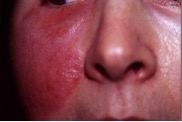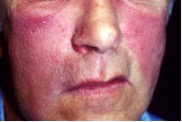Erysipelas
Content
When to Contact a Medical Professional
Erysipelas is a type of skin infection.
Causes
Erysipelas is usually caused by group A Streptococcus bacteria. The condition may affect both children and adults.
Some conditions that can lead to erysipelas are:
-
A cut in the skin
-
Problems with drainage through the veins or lymph system
-
Skin sores (ulcers)
The infection occurs on the legs most of the time. It may also occur on the face.
Symptoms
Symptoms of erysipelas are:
-
Blisters
-
Fever, shaking, and chills
-
Painful, very red, swollen, and warm skin underneath the sore
-
Skin sore with a raised border
-
Sores on the cheeks and bridge of the nose


Exams and Tests
Erysipelas is diagnosed based on how the skin looks. A biopsy of the skin is usually not needed.
Treatment
Antibiotics are used to get rid of the infection. If the infection is severe, antibiotics may need to be given through an IV (intravenous line).
People who have repeated episodes of erysipelas may need long-term antibiotics.
Outlook (Prognosis)
With treatment, the outcome is good. It may take a few weeks for the skin to return to normal. Peeling is common.
Possible Complications
Sometimes the bacteria that cause erysipelas may travel to the blood. This results in a condition called bacteremia. When this happens, the infection may spread to the heart valves, joints, and bones.
Other complications include:
-
Return of infection
-
Septic shock (a dangerous body-wide infection)
When to Contact a Medical Professional
Call your health care provider if you have a skin sore and other symptoms of erysipelas.
Prevention
Keep your skin healthy by avoiding dry skin and preventing cuts and scrapes. This may reduce the risk for erysipelas

